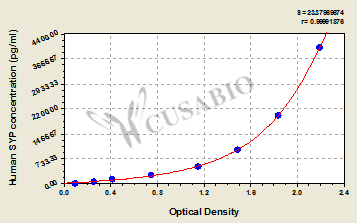Synaptophysin is an integral membrane glycoprotein found in presynaptic vesicles throughout the nervous system. As a member of the synaptophysin family, it plays an important role in synaptic vesicle formation and neurotransmitter release. This protein serves as a widely used marker for synaptic density and neuronal integrity in neuroscience research. Researchers commonly study synaptophysin expression levels in neurodegenerative diseases, synaptic plasticity research, and neuronal development studies. This makes it a valuable biomarker for measuring synaptic function and neuronal health.
The Human synaptophysin ELISA kit (CSB-E17406h) uses a quantitative sandwich measurement principle to detect SYP in serum, plasma, tissue homogenates, and cell lysates. The assay offers a detection range of 62.5 pg/mL to 4000 pg/mL with a sensitivity of 15.6 pg/mL. The protocol requires 50-100 μL sample volume and can be completed within 1-5 hours. Detection occurs at 450 nm wavelength, providing researchers with a reliable tool for quantifying human synaptophysin levels in various biological samples.
Application Examples
Note: The following application examples are drawn from a selection of publications citing this product. For additional applications, please refer to the full list of references in the "Citations" section.
This ELISA kit has been used in neurobiological research to quantify synaptophysin levels in extracellular vesicles and neuronally enriched vesicles isolated from human plasma samples. The applications focus on measuring synaptic protein markers as part of broader studies into neuronal function and synaptic integrity.
• Extracellular vesicle research: Quantification of synaptophysin in exosomal proteins alongside other synaptic markers to characterize vesicular protein content
• Neuronal vesicle studies: Measurement of synaptophysin levels in neuronally enriched extracellular vesicles following immunocapture isolation protocols
• Synaptic protein profiling: Analysis of synaptic protein markers in lysed vesicle preparations as part of comprehensive neuronal biomarker panels
• Plasma-based biomarker research: Analysis of synaptophysin content in circulating vesicles isolated from participant plasma samples






